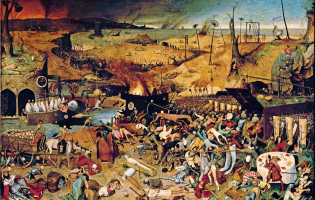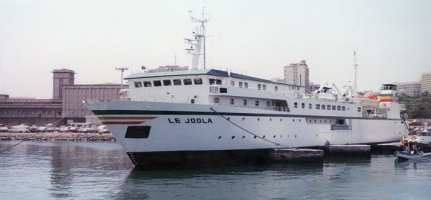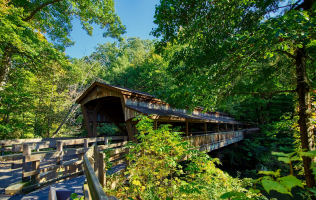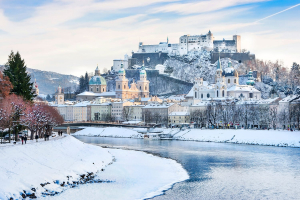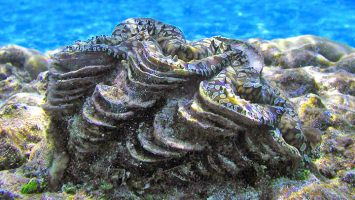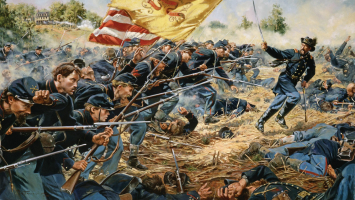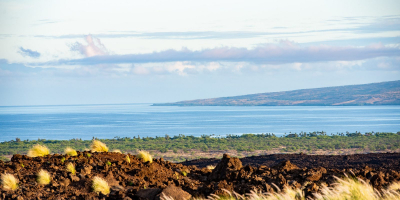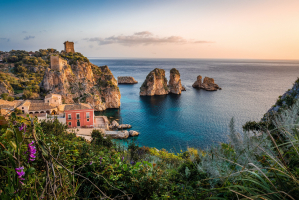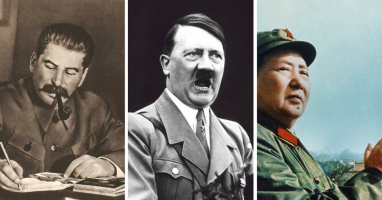Top 15 The Worst Winter Storms in American History
It seems that every time a big snowstorm is in the forecast, the media hails it as "record-breaking" or "historic," in some way or another. But how do these ... read more...storms truly match up to the worst storms to hit the United States? Here is a list of the worst winter storms in American history.
-
The Great Blizzard of 1888 (March 11–14, 1888), also known as the Great Blizzard of '88 or the Great White Hurricane, was one of the most severe recorded blizzards in American history. The storm paralyzed the East Coast from the Chesapeake Bay to Maine, as well as Canada's Atlantic provinces. The snowfall ranged from 10 to 58 inches (25 to 147 cm) in New Jersey, New York, Massachusetts, Rhode Island, and Connecticut, with sustained winds of more than 45 miles per hour (72 km/h) producing snowdrifts of more than 50 feet (15 m). Railroads were closed, and people were forced to stay in their homes for up to a week. Railway and telegraph lines were disabled, and this provided the impetus to move these pieces of infrastructure underground. Emergency services were also affected.
Just before the blizzard, the weather was unusually mild, with heavy rain that quickly turned to snow as temperatures dropped. The temperature in New York City dropped from 33 °F (1 °C) to 8 °F (13 °C) on March 12, and rain turned to snow at 1 a.m. The storm started in earnest shortly after midnight on March 12 and lasted a full day and a half. According to a 2007 article, the National Weather Service estimated that this nor'easter dumped up to 50 inches (130 cm) of snow in parts of Connecticut and Massachusetts and up to 40 inches (100 cm) in parts of New Jersey and New York. The majority of northern Vermont received between 20 and 30 inches (51 to 76 cm) of snow.
Drifts averaged 30-40 feet (9.1–12.2 m) over the tops of houses from New York to New England, with reports of three-story houses being affected. Gravesend, Brooklyn, had the highest drift, measuring 52 feet (16 meters). New York City received 22 inches (56 cm). Wind gusts of 80 miles per hour (129 km/h) were reported, though the highest official report in New York City was 40 miles per hour (64 km/h), with a 54 mile per hour (87 km/h) gust reported at Block Island. On March 13, New York City recorded a low of 6 °F (14 °C), the coldest for this time of year, with a high of only 12 °F (11 °C).
Type: Extratropical cyclone Blizzard
Lowest pressure: 980 hPa (29 inHg)
Maximum snowfall or ice accretion: 58 inches (147 cm)
Fatalities: 400 fatalities
Damage: $25 million in 1888 (equivalent to $750 million in 2022)
Areas affected: Eastern United States, Eastern CanadaFormed: 1888
https://www.youtube.com/ https://www.youtube.com/ -
On Thanksgiving weekend 1950, one of the most damaging and meteorologically unique winter storms to hit the eastern United States struck. After it passed, as much as 57 inches of snow blanketed the central Appalachians (with locally up to 62 inches at Coburn Creek, WV), and one of the most widespread and damaging wind events ever recorded over the northeastern United States made the Great Appalachian Storm of 1950 the costliest storm on record up to that point. East Kentucky was not spared, with many areas receiving record-breaking cold and more than a foot of snow.
The wild temperature gradient produced by the arctic airmass wrapping southeastward around the low while warm air from the Atlantic was pulled northwestward was a unique feature of this storm. For example, Pittsburgh, PA received 30.5" of snow and experienced temperatures in the single digits, while Buffalo, NY experienced temperatures in the 40s and no snow. The East Coast and New England were buffeted by strong winds. New York City recorded a peak wind gust of 94 mph, while Newark, NJ recorded a wind gust of 108 mph. Wind gusts of up to 160 mph were recorded on Mount Washington in New Hampshire, just north of New York City.
The high winds blew up the surf on the beaches, causing extensive tree damage and power outages. The resulting coastal flooding breached dikes at New York's LaGuardia Airport, flooding runways. On the warm side of the system, heavy rains caused near-record flooding in eastern Pennsylvania. By the time the storm passed over on November 29th and 30th, 160 people had died, and insurance companies had paid out more money to policyholders for damage than in any previous storm or hurricane.
Across eastern Kentucky, several days of snow added up to over a foot in many areas. Paintsville recorded 14”, Hazard and Manchester 13”, and Pineville received 11”. Bitter cold also gripped the area with most locations recording temperatures in the single digits to near zero on the 24th and 25th. Middlesboro bottomed out at 3ºF, Williamsburg 1ºF, Farmers 0ºF, and Somerset –2ºF. All but the 0ºF reading at Farmers still stand as record low temperatures for the month of November.
Type: Extratropical cyclone Nor'easter Blizzard Winter storm
Formed: November 24, 1950
Dissipated: November 30, 1950
Lowest pressure: 978 mbar (28.88 inHg)
Maximum snowfall or ice accretion: 57 inches (1,400 mm)
Fatalities: 383 fatalities
Damage: $66.7 million (1950 dollars)
Areas affected: Eastern United States Southeast Canadahttps://www.youtube.com/ https://www.youtube.com/ -
The March 1993 "Storm of the Century" hit Florida's gulf coast late on Friday, March 12, 1993, and continued to pound Florida and neighboring states on Saturday. What made it the Storm of the Century? To Floridians, it was a "no-name" March hurricane with wind gusts of over 90 mph, tornadoes, and a deadly storm surge. It was, however, much larger than a hurricane. Residents further north dubbed it "The Blizzard of the Century." A blizzard like no other, dropping temperatures, dumping snow, breaking trees, and knocking out power across a wide swath from Alabama and Georgia to Maine.
The Superstorm caused more than $2 billion in property damage in 22 eastern U.S. states. The majority of the property damage happened in Florida. With less than 100 direct casualties, advanced warnings saved lives, with half of them on vessels in seas as high as 65 feet. Another 118 people died as a result of indirect causes, with many of them dying during the post-storm cleanup.Computer models predicted a rapid development of intense low pressure over the Gulf of Mexico five days in advance. It was initially difficult to believe that a weak low-pressure area could rapidly deepen to levels much lower than expected. Some forecasters referred to the storm as a "meteorological bomb"! The numerical forecast models continued to show the same unbelievable development throughout the week. But it was happening. The arctic, polar, and subtropical jet streams were merging upstream, and a deep flow of tropical moisture was coming north from the Caribbean Sea over the Gulf of Mexico. These combining factors set the clock for the upcoming explosion.
As it moved onshore, the fast-moving squall line produced 59,000 cloud-to-ground lightning strikes. As the storm moved across the state, at least 11 tornadoes were reported. The F2 tornado near Chiefland in Levy County killed three people. Tornadoes also killed people in Alachua and Lake Counties. The Superstorm caused an unprecedented storm surge of up to 12 feet in Taylor County, which is located in the Florida Big Bend, north of Tampa Bay. Thirteen people drowned as a result of the surge.
Type: Extratropical cyclone Superstorm Nor'easter Blizzard Tornado outbreak Derecho Ice storm Gulf low
Formed: March 12, 1993
Dissipated: March 14, 1993
Fatalities: 318 fatalities
Damage: $5.5 billion (1993 USD)
Power outages: > 10,000,000
Areas affected: Eastern United States, Canada, Mexico, Cuba, Bahamas, Bermudahttps://www.youtube.com/ https://www.youtube.com/ -
The Great Lakes Storm of 1913 (also known as the "Big Blow," the "Freshwater Fury," and the "White Hurricane") was a hurricane-force wind blizzard that devastated the Great Lakes Basin in the midwestern United States and Southwestern Ontario, Canada from November 7 to 10, 1913. On November 9, the storm was at its strongest, battering and overturning ships on four of the five Great Lakes, particularly Lake Huron.
The storm was the deadliest and most destructive natural disaster in recorded history to hit the lakes. Over 250 people were killed. Shipping was particularly hard hit, with 19 ships destroyed and 19 others stranded. A cargo worth approximately $1 million and weighing approximately 68,300 tons, including coal, iron ore, and grain, was lost. The storm impacted many cities, including Duluth, Minnesota; Chicago, Illinois; and Cleveland, Ohio, which received 22 inches (56 cm) of snow and winds of up to 79 miles per hour (127 kilometers per hour) and were paralyzed for days.
The extratropical cyclone formed when two major storm fronts collided, fueled by the relatively warm waters of the lakes—a seasonal process known as a "November gale." It produced wind gusts of up to 90 mph (140 km/h), waves of up to 35 feet (11 m), and whiteout snowsqualls. For extended periods, winds exceeding hurricane force were experienced over four of the Great Lakes, resulting in very large waves.
The Great Lakes' massive size allows for wind fetches (the length of water over which a given wind has blown without obstruction) of hundreds of miles, allowing for massive waves to form. Rogue waves are known to occur on the Great Lakes, including waves reinforced by reflections from some of the Great Lakes' vertical shores. Waves on the Great Lakes can be steeper and closer together than on the ocean, allowing for less recovery time between waves. The Great Lakes also have less maneuvering "sea room" and are closer to shore, making it more difficult for ships to weather storms.
The United States Weather Bureau failed to predict the storm's intensity, and the process of preparing and communicating forecasts was slow. These factors all contributed to the storm's devastation. The forecasters did not have enough data, communications, analysis capability, or understanding of atmospheric dynamics to predict the storm at the time. They were unable to predict wind directions, which is critical to ships' ability to avoid or cope with the effects of storms.
Type: Extratropical cyclone Winter storm Blizzard
Formed: November 6, 1913
Dissipated: November 11, 1913
Highest gust: 90 mph (145 km/h)
Lowest pressure: 968.5 mb (28.60 inHg)
Areas affected: The Great Lakes Basin in the Midwestern United States and the Canadian province of Ontariohttps://www.youtube.com/ https://www.youtube.com/ -
The January 12, 1888 blizzard, dubbed the "Children's Blizzard" because so many children died while attempting to walk home from school, was one of the deadliest winter storms in the upper Midwest.
In comparison to the eastern Dakota Territory, Minnesota, Nebraska, and Iowa, the Black Hills area was spared the brunt of the storm. Despite the severity of the storm and its sudden onslaught, no lives were lost in this area, which was remarkable. The majority of people in southwestern Dakota Territory lived in and along the Black Hills, as well as a few towns south of Rapid City, which were safer than the plains. Although many residents were new to the Black Hills, many thought it was the worst storm they had ever seen.
The storm primarily disrupted transportation and communications, effectively isolating the Black Hills region from the rest of the region. For days, deep snow drifts blocked the Fremont, Elkhorn, and Missouri Valley Railroad tracks from Chadron, Nebraska to Rapid City and Whitewood, South Dakota, the only railroad line to the Black Hills. As the storm approached, the Western Union telegraph line went down, preventing information from reaching Rapid City, including the Cold Wave Warning issued by the Signal Office in St. Paul, Minnesota. Telephone service between Black Hills towns remained operational, allowing information to reach the media from outlying areas.
The U.S. Army Signal Corps office had recently moved to Rapid City from Deadwood, with observations starting January 1, 1888. The office was located in the Sweeney Building on the southwest corner of Main and Seventh Streets. Snow began falling in the early morning hours of January 12 and stopped around 11:20 a.m. local time. A total of 1.5 inches of snow was measured, but given the strong winds and the observation location on top of a three-story building, some of it most likely blew away before it could be measured.
As cold air poured into the area, temperatures dropped throughout the day from a high of 14 degrees shortly after midnight. The temperature had dropped to -10 by 8 p.m. The sustained north winds reached 30 miles per hour. The temperature had dropped to -21 degrees by 5 a.m. on January 13. The low temperature that morning was -25 degrees, and the high was only -10 degrees. Several low temperatures in the days following the storm set records that still stand today, and January 1888 ranks as the fifth coldest January in Rapid City.
Type: Extratropical cyclone Blizzard Winter storm
Formed: January 12, 1888
Dissipated: January 13, 1888
Maximum snowfall or ice accretion6 inches (15 cm)
Fatalities: 235 fatalities
Areas affected: Mid-Western UShttps://www.youtube.com/ https://www.youtube.com/ -
Among the worst winter storms in American history, the Blizzard of 1996 is one of them. Snow begins falling in Washington, D.C., and up and down the Eastern seaboard on January 6, 1996, kicking off a blizzard that kills 154 people and causes over $1 billion in damage before it ends. The 1996 blizzard began in a typical fashion, with cold air from Canada pushing down and colliding with relatively warm winds from the Gulf of Mexico. Because of the clashing weather fronts, there was a terrible combination of snow and wind. Snow began to fall in the District of Columbia around 9 p.m., with 12 inches falling over the next 24 hours. It was even worse in Lynchburg, Virginia, where a record 20 inches of snow fell in a single day. Wind gusts of up to 50 miles per hour caused snow drifts in many areas, making travel nearly impossible.
As the storm moved northeast, it set new records. Over several days, Newark, New Jersey, received a total of 28 inches of rain. Providence, Rhode Island, received 32 inches of rain, while Philadelphia received 30 inches. Due to the city's inability to clear the heavy snow from the streets quickly, Philadelphia schools were closed until January 16.
Overall, the blizzard caused significant damage to both people and property. A church roof in Harlem collapsed, injuring several New York City residents. Barns all over Pennsylvania were destroyed by the weight of the snow. As a precaution, many supermarkets in the region, many of which have large flat roofs, have closed. In Pittsburgh, two buses collided, leaving 52 people seriously injured. The storm deaths were primarily the result of traffic accidents, collapsed trees, and hypothermic homeless people. Carbon monoxide poisoning killed a few people who were trapped in their cars. With around 80 deaths, Pennsylvania had the most.
Type: Winter storm Blizzard
Form: January 6, 1996
Dissipated: January 10, 1996
Lowest pressure: 980 mb (28.94 inHg) at 7:00 am EST on January 8th
Maximum snowfall or ice accretion: 48 inches (120 cm), Pocahontas County, West Virginia
Fatalities: 154 fatalities total (another 33 took place during flooding after the storm)
Damage: US$3 billion
Areas affected: Continental United States; especially the Northeastern United Stateshttps://www.youtube.com/ https://www.youtube.com/ -
A rapidly deepening low-pressure system moved northeast from Kansas City, MO, through the Upper Mississippi River Valley and into the Upper Great Lakes on November 11, 1940. This low-pressure area resulted in the lowest pressure readings ever recorded at Charles City, IA (28.92 inches), La Crosse, WI (28.72 inches), and Duluth, MN (28.72 inches) (28.66 inches). Blue skies and temperatures in the 40s and 50s marked the start of Armistice Day (now known as Veteran's Day). The weather forecast called for colder temperatures and a few flurries that morning. The weather was so nice that duck hunters in short-sleeved shirts rushed to the Mississippi River marshes early that morning.
A strong cold front passed through the region in the late morning and early afternoon. The weather became blustery behind this front, and the temperature dropped to the single digits by the next morning. The rain turned to sleet, then to driving snow. Gale-force winds and threatening waves trapped twelve duck hunters on the Mississippi River between St. Paul and Prairie du Chien. These hunters sought refuge on small islands and died from exposure. The next day, rescue efforts were hampered by ice that had formed over the previous night.
Heavy snow fell across the Dakotas, as well as much of Minnesota, Iowa, and northwest Wisconsin. Collegeville, Minnesota had the most snowfall with 26.6 inches. Furthermore, winds of 30 to 50 mph caused significant blowing and drifting of snow, trapping unsuspecting motorists.
Near Willmar, Minnesota, 20-foot drifts were reported. The blizzard killed 49 people in Minnesota, and gales on Lake Michigan caused shipwrecks that killed another 59 people. The storm killed 154 people and killed thousands of cattle in Iowa. The storm killed over a million turkeys in Wisconsin, Minnesota, and other states. The storm was dubbed the "Armistice Day Storm."
This storm, along with a slow-moving blizzard that would move across northern Minnesota in mid-March 1941, caused the Weather Bureau to rethink its forecasting procedures. Forecasting for the entire region had been directed by the Chicago office, but in the wake of this storm, responsibilities were distributed to regional centers to provide more timely and accurate predictions. This is one of the worst winter storms in American history.
Extratropical cyclone Blizzard Panhandle Hook
Formed: November 10, 1940
Dissipated: November 12, 1940
Lowest pressure: 971 mbar (hPa) (at Duluth, MN)
Maximum snowfall or ice accretion: 27 inches (68.6 cm) (Collegeville, MN)
Fatalities: 154 fatalities
Damage: $2.2 million (1940)
Areas affected: Midwestern United Stateshttps://www.youtube.com/ https://www.youtube.com/ -
When it comes to the worst winter storms in American history, can't help but mention the Knickerbocker Storm. A major snowstorm hit the region around Washington DC on January 27, 1922, dumping more than 71cm (28 inches) of snow. This was a particularly heavy fall, and tragedy was to ensue. The Knickerbocker Theatre was packed with 900 people to see Get-Rich-Quick Wallingford, a new silent film. The Knickerbocker, one of the city's newest and largest cinemas, had an unusual flat roof.
The movie started at 9 p.m. The roof gave way under the weight of snow without warning, with no cracking or creaking. It collapsed, bringing the balcony inside the theatre down with it. Hundreds of soldiers helped rescue victims from the rubble. 98 people were killed and many more were injured, including a violinist in the orchestra whose arm had to be amputated.
Building codes were quickly updated with a requirement for steel beams to support flat roofs, and movie theaters in the capital were shut down for inspection. The Knickerbocker's construction was flawed, and both the architect and the building's owner committed suicide. However, the lawsuit was unsuccessful, and neither the victims nor their families ever received compensation. The storm later became known as the Knickerbocker snowstorm, and any heavy snowfall in Washington triggered speculation about another building collapse.
Type: Extratropical cyclone Blizzard
Formed: January 27, 1922
Dissipated: January 29, 1922
Fatalities: 98 fatalities, 133 injured
Areas affected: Mid-Atlantic states of the United Stateshttps://www.youtube.com/ https://www.youtube.com/ -
The Great Storm of 1975 (also known as the Super Bowl Blizzard, Minnesota's Storm of the Century, or the January Tornado Outbreak) was an intense storm system that impacted a large portion of the central and southeast United States from January 9 to January 12, 1975. The storm produced 45 tornadoes in the Southeast United States, killing 12 people, before dropping over 2 feet (61 cm) of snow and killing 58 people in the Midwest. This storm is still remembered as one of the worst blizzards to hit the Midwest as well as one of the largest January tornado outbreaks on record in the United States.
On January 8, 1975, the storm formed over the Pacific Ocean and slammed into the Northwest Pacific Coast with damaging gale-force winds. It had cleared the Rocky Mountains by January 9 and was redeveloping and strengthening. At the same time, Arctic air was being drawn south from Canada into the Great Plains, while warm tropical air from the Gulf of Mexico was being drawn north into much of the eastern United States. The storm was a classic Panhandle Hook that moved from Colorado into Oklahoma before heading north into the Upper Midwest. It resulted in record-low barometric pressure readings in the Midwest, with pressure dropping to an estimated 28.38 in (961 mb) just north of the Minnesota border in Canada.
Type: Extratropical cyclone Winter storm Blizzard Panhandle Hook Tornado outbreak
Formed: January 9, 1975
Dissipated: January 12, 1975
Fatalities: 58 fatalities, unknown injuries (snow); 12 fatalities, 377 injuries (tornado)
Damage: US$20 million (snow); US$43 million (tornado)
Areas affected: Midwest and Southeast United Stateshttps://www.youtube.com/ https://www.youtube.com/ -
That's exactly what happened near the turn of the twentieth century, when the Great Blizzard of 1899 engulfed the eastern half of the continent, from Saskatchewan to Cuba. The storm, which began in Canada on February 11th and lasted until February 14th, was notable in part because it disproportionately affected southern areas that are accustomed to much milder winter conditions. A photograph from the time shows government officials in Tallahassee, Florida, having a snowball fight on the state capitol building's stairs. The southern United States had never seen such severe winter weather before, and it has only done so once since 1985 when a deep freeze destroyed many of Florida's citrus groves.
Aside from the storm's massive size, it was also notable for bringing record-low temperatures to much of the country, many of which still stand to this day. Cape May, New Jersey, dropped to 0°F, the coldest temperature ever recorded in Cape May County, and received 34 inches of snow, a state record. Tallahassee dropped to -2° F, the state's only sub-zero temperature in recorded history. Atlanta, Georgia, reached a bone-chilling -9° F, a record low. Washington, D.C., hit -15° F, an all-time low for the city, and received 51 straight hours of snow. Other areas had even lower temperatures: -33 °F in Sandy Hook, Kentucky; -35° F in Dayton, West Virginia; -39° F in Milligan, Ohio; -47° F in Camp Clark, Nebraska; and a bone-chilling -61° F in Fort Logan, Montana!
Even New Orleans, which is normally hot, had a sub-freezing temperature of 22° F during its Mardi Gras celebrations that year. The city was completely engulfed in ice, and revelers had to wait for the snow to be shoveled from parade routes.
Type: Winter storm and historic cold wave
Formed: February 10, 1899
Dissipated: February 14, 1899
Fatalities: Over 100 deaths
Areas affected: United States, particularly east of the Rocky Mountainshttps://www.youtube.com/ https://www.youtube.com/ -
Chicago experienced its worst snowstorm on record on January 26-27, 1967. The snow began at 5:02 a.m. on Thursday, January 26, and by 10:10 a.m. the next day, the city had received a record 23.0 inches of snowfall from a storm. High winds caused significant blowing, with drifts of 4 to 6 feet common throughout the area.
The high temperature was a record 65°F just two days before the storm, and the low was 44°F. However, on January 25, a cold front passed through the upper Midwest, replacing the warm weather. Dew points in the 50s and 60s provided ample moisture over the Southern Plains and Gulf Coast states, while high pressure centered over Lake Superior and southern Ontario kept cold, dry air moving over the Great Lakes. Winds howled off Lake Michigan as a result of the high and low pressure over the Ohio Valley.
By noon, there was about 8 inches of snow on the ground, and O'Hare airport was closed. Although some schools and businesses released students and employees early, the commute home remained hazardous. By Friday morning, Chicago had come to a halt, with 20,000 cars and 1,100 CTA buses stranded. Helicopters dropped off medical supplies at hospitals, as well as food and blankets for stranded motorists. At least a dozen babies were born at home, though some mothers were transported to hospitals by sled, bulldozer, and snowplow.
Chicago had begun to dig itself out by January 28. Although CTA buses were running on most lines, abandoned vehicles hampered cleanup, and snow had to be hauled to the Chicago River by dump truck. Railcars of snow were even delivered to Fort Myers Beach, Florida, after Terri Hodson, a 13-year-old girl who had never seen snow before, wrote a letter to the president of the Chicago, Burlington and Quincy Railroad.
Although O'Hare Airport reopened around midnight on Monday, January 30, most schools did not reopen until Tuesday. In the end, 60 people died in the Chicago area, and business losses were estimated to be $150 million (equivalent to $1.19 billion today). The snowstorm caused the most disruption to Chicago commerce and transportation since the Great Chicago Fire of 1871.
Type: Blizzard with thunderstorms
Formed: January 26, 1967
Duration: 29 hours
Dissipated: January 27, 1967
Casualties: 26 deaths in Chicago, 60 in region
Damage: $150 million (1967 dollars); all transportation stopped
Areas affected: Northeastern Illinois and Northwestern Indianahttps://www.youtube.com https://www.youtube.com/ -
It was the "Presidents Day Blizzard" for New York City and Boston, and a crippling snowstorm for Washington, D.C., Baltimore, MD, and Philadelphia, PA. When the amount of snow and overall impact of the storm in the major east coast cities is compared to what happened in the Capital Region, it is safe to say that the region received a glancing blow. Nonetheless, the "Glancing" blow dumped up to a foot of new snow in the immediate Capital Region, with 14"–20" in the eastern Catskills, mid Hudson Valley, and Berkshire and Litchfield counties. Surprisingly, the actual surface storm that contributed to the snowfall was weak and poorly defined. As a result, the Northeast corridor was pummeled by a significant, and in many places, record-breaking, snowfall in the absence of a major coastal storm.
Wind gusts of more than 40 mph in New York and Boston created the necessary blowing snow and reduced visibility criteria for at least three hours, allowing the system to be classified as a blizzard in those cities, despite the fact that true blizzard conditions were relatively brief. 27.5" of snow fell on Boston, the most from any storm, 20" on New York City, the city's fourth-heaviest snowfall ever, and 20"-24" fell on Washington, Baltimore, and Philadelphia, setting snowfall records and crippling those cities for days. Up to 50 inches of snow fell in the mountains of eastern West Virginia and western Maryland, with snow sleet and freezing rain falling further south in Virginia and North Carolina.
Type: Winter storm
Formed: February 14, 2003
Dissipated: February 22, 2003Fatalities: 2 fatalities direct, 25 indirect
Damage: Over $14.1 million
Areas affected: Southern Rockies, Central United States, Eastern North Americahttps://www.youtube.com https://www.youtube.com/ -
The North American blizzard of 2005 was a three-day storm that hit much of the northern United States, dumping more than 3 feet (0.9 m) of snow in parts of southeastern Massachusetts and much of the Boston metropolitan area. While this was by far the hardest hit region, it was also a significant snowstorm for the Philadelphia and New York City areas, which both experienced blizzard conditions and snow accumulations of 12–15 in (30–38 cm).
On Thursday, January 20, 2005, the storm began to dump snow in the upper Midwest. On Friday and Saturday, January 21 and 22, 2005, it moved slowly eastward, affecting the Great Lakes region and the Mid-Atlantic states. The storm made landfall in Southern New England on Saturday evening. The storm's strength, combined with the extreme Arctic temperatures, produced light, fluffy snow, increasing snowfall totals. Logan International Airport in Boston, Massachusetts, as well as T. F.
Green Airport in Rhode Island, while also impeding travel throughout much of Massachusetts due to the heavy snowfall. Almost all schools in Massachusetts' Metrowest and South East regions were closed for at least two days. For up to a week, Cape Cod Community College, as well as all public schools on Cape Cod, Martha's Vineyard, and Nantucket, were closed. After crossing the Atlantic Ocean, the storm system hit parts of the United Kingdom, Ireland, and the Scandinavian peninsula, causing widespread blackouts and a small number of deaths. It's considered one of the worst winter storms in American history.
Type: Extratropical cyclone Blizzard Winter storm
Formed: January 20, 2005
Dissipated: January 23, 2005
Fatalities: At least 12
Damage: Unknown
Areas affected: Upper Midwest, Great Lakes Region, Northeastern United States, British Isles, Scandinavian Peninsulahttps://www.youtube.com/ https://www.youtube.com/ -
On the morning of February 11, 2006, a snowstorm hit New York City, shattering all previous snowfall records dating back to 1869. The 2006 storm, like all previous blizzards, caused widespread chaos, disrupted transportation systems, and covered streets with nearly 27 inches of snow, a half-inch increase over the previous record, set in 1947. Although most people would mistake this storm for a blizzard in retrospect, it never met the criteria for classification. A blizzard is defined as having high winds and temperatures below zero. The official meteorologist report classified the 2006 storm as a nor'easter with wind speeds ranging from 20 to 30 miles per hour.
Having previously dealt with snow storms on this scale, the city of New York employed 5,000 sanitation workers to spread approximately 200,000 tons of salt on the streets. Plows worked around the clock to combat the accumulation on major highways, with snowfall reaching 3 inches per hour, but many streets remained untouched. Snowfall at LaGuardia and Kennedy airports was deemed hazardous, and flights were canceled until further notice. For a time, the LIRR and Metro-North railroad services were canceled, and major subway lines were delayed.
Fortunately, the storm hit during the weekend, when most city dwellers were not required to travel to work or school. Con Edison did not report any power outages during the storm, which was attributed to the dry texture and lightness of the snow caused by the 20-degree temperatures. Some city dwellers were unfazed by the storm and went out to enjoy the winter wonderland with family and friends.
Type: Extratropical cyclone Nor'easter Blizzard Winter storm
Formed: February 11, 2006
Dissipated: February 13, 2006
Fatalities: 0 direct, 3 indirect
Damage: $5 million (2006 USD)
Power outages: 506,000
Areas affected: Virginia, Maryland, District of Columbia, Pennsylvania, New York, New Jersey, Delaware, New England, Atlantic Canadahttps://www.youtube.com/ https://www.youtube.com/ -
The North American blizzard of February 5–6, 2010, colloquially known as Snowmageddon, was a major and widespread blizzard in the Northeastern United States. The storm's center moved from Baja California Sur to the east coast on February 2, 2010, before heading east into the Atlantic. The effects of this track were felt in northern Mexico, California, and the southwestern, midwestern, southeastern, and, most notably, mid-Atlantic states. Severe weather, including extensive flooding and landslides in Mexico as well as historic snowfall totals in every Mid-Atlantic state, claimed the lives of people in Mexico, New Mexico, Virginia, Pennsylvania, and Maryland.
The most crippling factor was the widespread accumulation of 20 to 35 inches (50 to 90 cm) of snow across southern Pennsylvania, the Eastern Panhandle of West Virginia, northern Virginia, Washington, D.C., Maryland, Delaware, and South Jersey, which halted air and interstate highway travel. Rail service south and west of Washington, D.C. was suspended, and only limited service was available between D.C. and Boston. Blizzard conditions were reported in a small area of Maryland, but near-blizzard conditions were experienced across much of the Mid-Atlantic region.
This event was the second of four nor'easters during the 2009–2010 winter that brought heavy snow to enough of the Northeast's population to be numerically recognized by NOAA's NESIS intensity rating. The first and third of these systems, the December 2009 Nor'Easter and the February 9–10, 2010 North American blizzard, respectively, combined with this event to bring the snowiest winter on record to much of the Mid-Atlantic. Additionally, this event was the second of three major Mid-Atlantic snowstorms that occurred over a 12-day period; each subsequent storm focused its heaviest snow slightly farther north: the January 30, 2010 storm (not recognized by NESIS) dropped more than a foot of snow across Virginia and the lower Chesapeake Bay region, while the February 9–10, 2010 North American blizzard bulls-eyed the Maryland-Pennsylvania border with as much as 38.3 inches
Type: Extratropical cyclone Winter storm Nor'easter Blizzard
Formed: February 1, 2010
Dissipated: February 11, 2010
Fatalities: At least 41 fatalities (including at least 28 in Mexico and 13 in the US)
Areas affected: Midwest and East Coast of the United States (from Illinois to Georgia to Vermont)New Mexico, Mexico, Eastern Canada, California, Arizonahttps://www.youtube.com/ https://www.youtube.com/

















